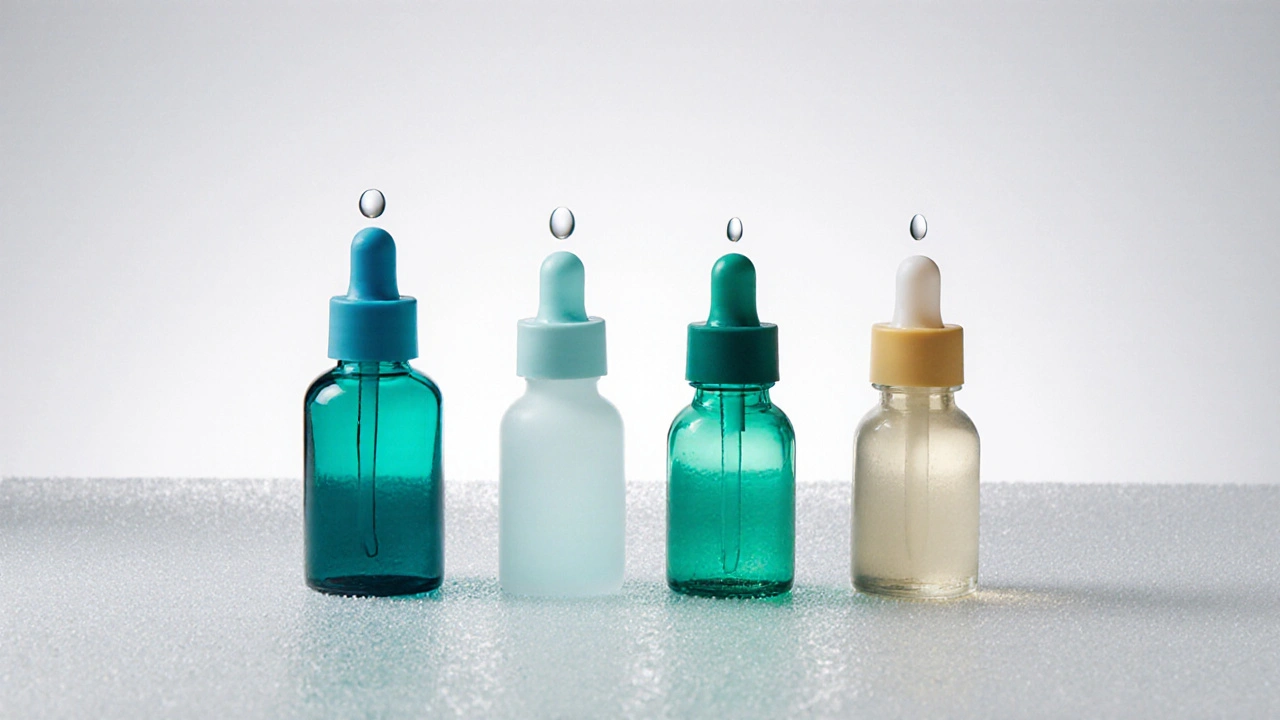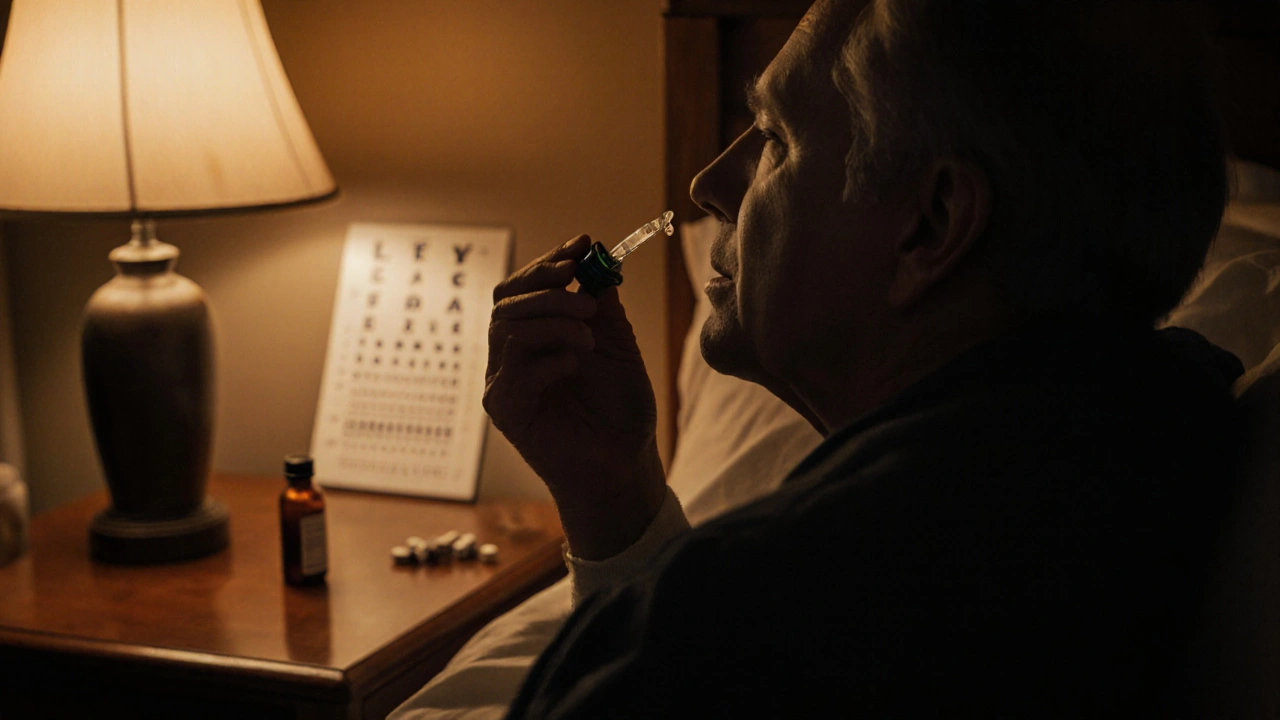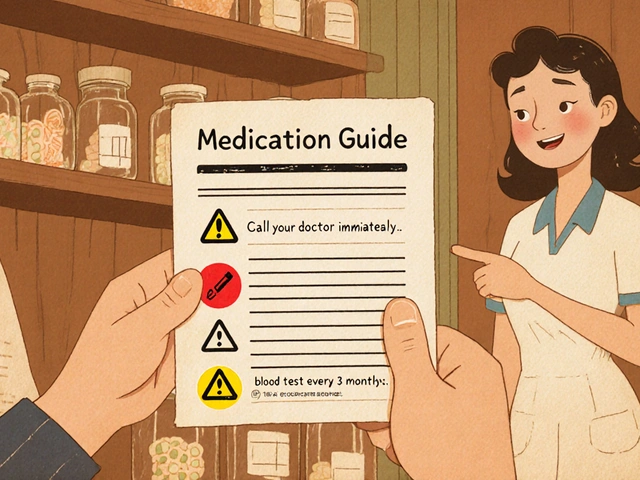Lumigan (Bimatoprost) vs Other Glaucoma Eye Drops: A Detailed Comparison
Glaucoma Eye Drop Selector
Find Your Best Match
Answer these 3 priority questions to get a personalized recommendation based on clinical data from the article.
Key Takeaways
- Lumigan (bimatoprost) is one of the most potent prostaglandin analogs for lowering intraocular pressure.
- Alternatives such as latanoprost, travoprost and tafluprost offer similar efficacy with different side‑effect profiles and costs.
- Choosing the right drop depends on potency, tolerance, preservative content and insurance coverage.
- Generic bimatoprost provides a cost‑effective way to keep the same therapeutic effect.
- Regular monitoring of intraocular pressure and side effects is essential regardless of the product you use.
Glaucoma patients often wonder whether the brand‑name drop they were prescribed is the only option. The short answer is no - there are several prostaglandin analogs on the market that work in the same way, but they differ in how strong they are, how often they cause side effects, and how much they cost. This guide walks you through the most common alternatives to Lumigan, compares their key attributes, and helps you decide which one fits your lifestyle and budget.
How Prostaglandin Analogs Lower Eye Pressure
All prostaglandin analogs belong to a drug class that increases the outflow of aqueous humor, the fluid inside the eye. By improving drainage through the uveoscleral pathway, these drops reduce intraocular pressure (IOP), the main risk factor for optic nerve damage in open‑angle glaucoma and ocular hypertension.
The class includes bimatoprost, latanoprost, travoprost and tafluprost. They share a similar mechanism but vary in chemical structure, receptor affinity, and formulation (preservative‑free vs preserved). Understanding these nuances is crucial when you compare products.
Lumigan (Bimatoprost) Overview
When treating glaucoma, Lumigan bimatoprost is a prescription eye drop that belongs to the prostaglandin analog class and is used to reduce intraocular pressure in glaucoma patients is available in a 0.01% solution, typically dosed once nightly.
Clinical trials show an average IOP reduction of 30% from baseline, making it one of the most potent options. The main side effects are conjunctival hyperemia (red eye), increased eyelash growth, and occasional iris darkening. Lumigan contains the preservative benzalkonium chloride (BAK), which can irritate sensitive eyes.

Top Alternatives to Lumigan
1. Latanoprost (Xalatan)
Latanoprost is a prostaglandin F‑type analog marketed under the brand name Xalatan comes in a 0.005% solution and is also administered once daily at night. It achieves an average IOP drop of 25‑28%.
Patients often report milder redness compared with Lumigan, but eyelash growth can still occur. A generic version is widely available, lowering the out‑of‑pocket cost.
2. Travoprost (Travatan Z)
Travoprost is a prostaglandin analog sold as Travatan Z, formulated with a preservative‑free option (Travatan Z®) and a BAK‑containing version is dosed once nightly at 0.004% concentration. IOP reduction averages 26‑29%.
The preservative‑free formulation is a big plus for patients with dry‑eye syndrome. However, it tends to be a bit pricier than generic latanoprost.
3. Tafluprost (Zioptan)
Tafluprost is a newer prostaglandin F‑type analog that is available only in a preservative‑free formulation (Zioptan) is used at 0.0015% once daily. Clinical data show a 24‑27% IOP drop, comparable to latanoprost.
Its preservative‑free nature makes it the least irritating for patients with ocular surface disease, but insurance coverage can be limited, raising the cost.
4. Generic Bimatoprost
Generic bimatoprost offers the same active ingredient as Lumigan but without the brand‑name premium is sold in 0.01% bottles, often in preservative‑free formulations. Efficacy mirrors Lumigan’s 30% IOP reduction, with a similar side‑effect profile.
The primary advantage is cost - many pharmacies price generic bimatoprost at a fraction of the brand price, making it a smart choice for patients on a budget.
Side‑Effect Profile Comparison
| Drug | Redness (Conjunctival Hyperemia) | Eyelash Growth | Preservative | Average IOP Reduction |
|---|---|---|---|---|
| Lumigan (bimatoprost) | High (30‑40% of users) | Common | BAK | ≈30% |
| Latanoprost | Moderate (15‑20%) | Common | BAK (generic may be preservative‑free) | 25‑28% |
| Travoprost (preservative‑free) | Low‑Moderate (10‑15%) | Occasional | None (Travatan Z®) | 26‑29% |
| Tafluprost | Low (5‑10%) | Rare | None (Zioptan) | 24‑27% |
| Generic bimatoprost | Similar to brand (high) | Common | Often preservative‑free | ≈30% |
Decision‑Making Criteria
- Potency: If you need the strongest IOP drop, bimatoprost (brand or generic) leads.
- Tolerance: For sensitive eyes, preservative‑free travoprost or tafluprost reduce irritation.
- Cost: Generic latanoprost and generic bimatoprost are the most affordable.
- Insurance coverage: Many plans favor latanoprost; check formularies before switching.
- Side‑effect priorities: If you dislike eyelash growth, tafluprost has the lowest incidence.

How to Choose the Right Drop for You
Start by discussing your IOP target with your ophthalmologist. If your pressure is just above the goal, a milder agent like latanoprost may suffice. If you have a high baseline pressure or rapid progression, stepping up to bimatoprost (brand or generic) offers the strongest reduction.
Evaluate ocular surface health. Patients with dry‑eye disease or allergies often benefit from preservative‑free options such as travoprost (Travatan Z®) or tafluprost.
Consider lifestyle and cost. Night‑time dosing works for most patients, but if you forget doses, a once‑daily regimen with a lower side‑effect profile may improve adherence.
Practical Tips for All Glaucoma Drops
- Never touch the tip of the bottle to your eye or any surface - this can contaminate the solution.
- Apply the drop before bedtime, allowing the eyelid to close gently for about two minutes.
- If you use more than one eye‑drop medication, wait at least five minutes between each to avoid dilution.
- Store drops at room temperature, away from direct sunlight; replace after the expiration date.
- Schedule regular IOP checks (usually every 3-6 months) to confirm the medication is working.
Frequently Asked Questions
Can I switch from Lumigan to a generic version without the doctor’s approval?
It’s best to get a green light from your ophthalmologist. Although the active ingredient is the same, differences in formulation (preservatives, bottle design) can affect comfort and IOP control.
Why does my eye turn red after using Lumigan?
Bimatoprost increases blood flow to the conjunctiva, which often shows as redness. If the redness is severe or painful, contact your eye doctor - a switch to a lower‑irritant alternative may be needed.
Is eyelash growth permanent after using prostaglandin drops?
The effect is reversible. Once you stop the medication, lashes gradually return to their normal length over a few months.
Which option is cheapest for someone without insurance?
Generic latanoprost is typically the most affordable, often under $20 for a month’s supply. Generic bimatoprost is a close second, especially when bought in bulk.
Do preservative‑free drops work as well as those with BAK?
Clinical trials show comparable IOP reduction. The main benefit of preservative‑free formulas is better tolerance for sensitive eyes.
Next Steps
1. Review your recent IOP measurements and any side‑effects you’ve noticed.
2. Bring this comparison to your next eye‑care appointment and discuss which alternative aligns with your goals.
3. If cost is a concern, ask your pharmacist about generic options and any patient‑assistance programs.







8 Comments
Mike Gilmer2
October 12, 2025 at 05:22
Man, reading that breakdown of Lumigan versus the other drops felt like watching a blockbuster showdown-bimatoprost struts in like the main hero, slashing IOP by a solid 30% while the rest of the cast tries to keep up. The side‑effect drama? Redness and lash growth stealing the spotlight, but hey, if you need that pressure drop, you might as well roll out the red carpet. Cost-wise, the generic versions are the underdogs that actually save you cash without pulling a fast one on efficacy. And don’t even get me started on preservative‑free options-those are the indie films that win the hearts of dry‑eye sufferers. Bottom line: pick the drop that fits your script, whether you’re after power, comfort, or a budget‑friendly plot twist.
Alexia Rozendo
October 20, 2025 at 19:22
Oh sure, because who doesn’t love a drop that turns your eye into a rave venue? 🙄
Kimberly Newell
October 29, 2025 at 09:22
hey folks, just wanted to say i totally get the confusion-sometimes the names sound like sci‑fi weapons but they’re just eye meds, lol. if ur budget’s tight, try generic latanoprost or generic bimatoprost, they work just as good and won’t break the bank. also, preservative‑free drops are great if ur eyes get dry easy. any of these choices are legit, so chat with ur doc and pick what feels right for ya. stay safe!
Drew Burgy
November 6, 2025 at 23:22
Listen up, because the pharmaceutical giants have been playing us like puppets in a shadowy theater for decades. The data you just read is polished, but what they don’t tell you is that the “clinical trials” were funded by the same companies selling Lumigan at premium prices. They cherry‑pick the patients who respond best, then broadcast those results as universal truths. Meanwhile, the cheaper generics get buried under layers of marketing smoke, even though they contain the identical active molecule. You’ll also notice a pattern: every time a preservative‑free formula appears, the price spikes-another clever way to siphon off money from the unsuspecting. They claim BAK is “necessary,” yet studies from independent labs show it’s the main irritant causing that dreaded redness. The real agenda is to keep you dependent on office visits where they can push the next “new and improved” drop. Consider the geopolitical angle: a lot of the raw material for bimatoprost comes from regions under heavy regulation, giving the manufacturers a convenient excuse to control supply and dictate prices. The side‑effect profile isn’t a flaw; it’s a feature that makes patients more likely to report back and get a “new prescription,” which in turn fuels the cycle. And don’t be fooled by the fancy branding-bimatoprost is essentially the same molecule whether it’s sold under a brand name or a generic label. The only real difference is the bottle design, the preservatives, and the profit margin. So when you’re deciding between Lumigan and the alternatives, ask yourself: am I buying a drug or a corporate loyalty card? Remember, the eye can only handle so much irritation before it starts compromising vision, which is exactly what they hope you’ll ignore until it’s too late. In short, the market is engineered to keep you guessing, spending, and constantly coming back for more. Keep your eyes open-literally and figuratively-and push back against the hype.
Jacob Hamblin
November 15, 2025 at 13:22
That was a thorough run‑through, and I appreciate how you backed each claim with a clear logical flow. While the conspiratorial tone adds spice, the factual points about BAK irritation and generic efficacy are spot on. It’s essential for patients to weigh both the clinical data and the real‑world cost factors before making a decision. I’d also suggest double‑checking the expiration dates on any eye‑drop bottles, as potency can decline over time. Ultimately, a balanced conversation with your ophthalmologist will help you land on the safest and most effective option.
Andrea Mathias
November 24, 2025 at 03:22
Wow, what a whirlwind of drama-so typical when someone tries to sound all “expert” while actually just spewing nonsense. If you think tossing around “shadowy theater” makes you sound smart, think again; it just shows how little you understand the actual science. Let’s get real: Lumigan works, generic bimatoprost works, and the rest are just marketing fluff. Stop feeding the hype train and start listening to your doctor, because that’s where the real answers lie, not some conspiracy‑laden blog post.
TRICIA TUCKER
December 2, 2025 at 17:22
Yo! Money matters, right? If you’re hunting for the cheapest but still effective drop, generic latanoprost is the way to go. I’ve been on it for a few months and the pressure’s solid, plus my wallet’s happy. For those who can splurge a bit, the preservative‑free travoprost feels super gentle on the eyes. Bottom line: chat with your eye doc, compare prices, and pick what vibes with your budget and comfort.
Dave Tu
December 11, 2025 at 07:22
While the enthusiasm for cost‑saving options is commendable, it is imperative to acknowledge that not all generic formulations adhere to identical bioequivalence standards. Certain preservative‑free variants may exhibit altered pharmacokinetics, potentially diminishing intraocular pressure reduction. Consequently, a blanket recommendation for generics without rigorous individual assessment could inadvertently compromise therapeutic outcomes. It is therefore advisable to evaluate each product on a case‑by‑case basis, considering both clinical efficacy and patient tolerance.